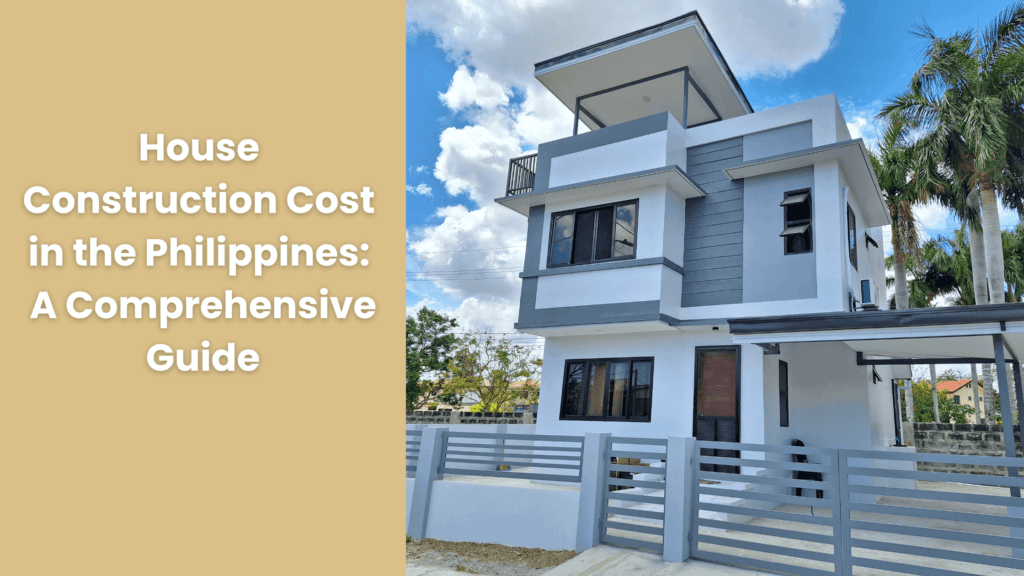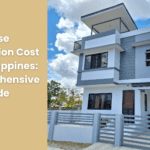House construction costs in the Philippines vary depending on factors such as location, materials, labor, and project scope. It has seen a steady increase due to inflation and rising material costs in 2024.
If you are planning to build your house, accurate knowledge of construction costs allows you to set realistic budgets, minimizing the risk of financial strain during the building process. This helps you identify potential cost-saving opportunities, make informed decisions about materials, design choices, and methods.
Also, familiarity with construction costs helps you evaluate the return on investment (ROI) for property investments, ensuring you get a more profitable and sustainable outcome.
This blog post aims to provide a comprehensive overview of house construction costs in the Philippines in 2024, helping you or potential homeowners and investors make informed decisions.
Here, we will discuss the factors that influence the costs, provide a breakdown of expenses, and offer strategies for managing costs effectively.
Factors Affecting House Construction Costs in the Philippines
- Location and accessibility
Land prices can vary greatly across the Philippines, with higher costs in urban areas like Metro Manila and lower costs in rural provinces. The accessibility to the construction site can influence transportation costs for materials, equipment, and labor. Also, regional differences in labor and material costs can also impact the overall project budget.
- Size and complexity of the design
The larger the house, the higher the construction costs due to increased materials and labor requirements. Complex designs with intricate details, multiple stories, or non-standard structural elements require more time, skill, and resources, which can increase the price.
- Choice of materials and finishes
Higher-quality materials typically come with a higher price tag, impacting the overall construction cost. Luxury finishes, such as high-end appliances, custom cabinetry, or imported tiles, can significantly increase project expenses.
However, local, eco-friendly, or cost-effective materials may help reduce building costs without compromising quality.
- Labor costs and availability
In the Philippines, labor costs can range from PHP 500 to PHP 800 per day, depending on the worker’s skill level and experience. Labor costs may be higher in urban areas due to increased demand and a higher cost of living. It’s also important to note that the availability of skilled labor may affect project timelines, potentially leading to increased costs if delays occur.
- Permits, licenses, and taxes
Building permits, occupancy permits, and other required licenses can add to the construction costs in the Philippines. Permit costs depend on the location, size, and scope of the project, with fees ranging from PHP 10,000 to PHP 50,000 or more. Taxes, such as Value Added Tax (VAT) and Real Property Tax, must also be factored into the overall project budget.
- Inflation and currency fluctuations
The Philippines experienced an average annual inflation rate of around 3% between 2018 and 2024, affecting the prices of construction materials and labor. Also, the country’s peso’s exchange rate fluctuations can influence the cost of imported materials and equipment, impacting the overall construction budget. The future economic changes and global market conditions can also affect the construction costs in the country.
Types of House Construction Projects and Their Costs
Based on Statista, from 1st quarter 2020 to 4th quarter 2023, the residential construction price per square meter in the country is 11,310 Php. You can multiply the home building cost per square meter by the total floor area of the property to get a sample house construction cost estimate.
However, if you want a more detailed cost estimate in 2024, you’ll need to consult with a house contractor.
Based on our research, we came up with the following pricing range for housing projects in the CALABARZON region for the third quarter of 2024:
A. Low-cost housing projects
(PHP 20,000 to PHP 25,000 per square meter)
Low-cost housing projects focus on affordability and functionality, typically targeting first-time homeowners or those with limited budgets. These projects often utilize cost-effective materials, simple designs, and compact floor plans to minimize expenses.
B. Mid-range residential projects
(PHP 30,000 to PHP 35,000 per sqm.)
Mid-range residential projects cater to middle-class homeowners seeking a balance between affordability and quality. These projects typically feature moderate-sized homes with upgraded finishes, additional amenities, and more complex designs than low-cost housing projects.
C. High-end luxury homes
(PHP 35,000 to over PHP 50,000 per square meter)
High-end luxury homes target affluent homeowners who prioritize premium materials, advanced features, and innovative designs. These projects often include custom designs, top-of-the-line finishes, and smart home technology, resulting in higher construction costs.
D. Custom-built homes
Custom-built homes are tailored to the specific needs and preferences of the homeowner, involving a more personalized design and building process. The construction costs for custom-built homes in the Philippines can vary significantly depending on the design, materials, and level of customization involved.
Homeowners seeking a custom-built home should expect to pay anywhere from PHP 28,000 to PHP 50,000 or more per square meter, depending on the project’s complexity and desired features.
E. Home renovations and extensions
Home renovations and extensions involve updating, modifying, or expanding an existing structure, which can range from minor cosmetic updates to major structural changes. So, homeowners should consider factors such as the current structure’s condition, necessary permits, and potential challenges when budgeting for a renovation or extension project.
The renovation costs in the Philippines depend on the scope of work, materials, and labor involved, with average costs ranging from PHP 20,000 to PHP 30,000 per square meter in 2024.
Breakdown of House Construction Costs in the Philippines
- Foundation and structural work
Foundation and structural work typically accounts for 15-20% of the total construction cost. Costs depend on factors such as soil type, terrain, and the choice of foundation system (e.g., strip footing, mat foundation, or pile foundation).
Reinforced concrete is the most common material for foundations and structural work in the Philippines, with costs ranging from PHP 2,000 to PHP 4,000 per cubic meter.
- Masonry and walls
Masonry and walls make up approximately 15-20% of the total construction cost. Common materials include concrete hollow blocks (CHB), which cost around PHP 15 to PHP 30 per piece, and mortar, which costs around PHP 200 to PHP 300 per bag.
Additional expenses may arise from wall finishes such as paint, tiles, or cladding.
- Roofing and insulation
Roofing and insulation account for about 10-15% of the total construction cost. Skillion roofs, which are popular in the Philippines, typically use long-span roofing materials like pre-painted metal or asphalt shingles, with costs ranging from PHP 300 to PHP 1,000 per square meter. Insulation materials, such as fiberglass or reflective foil, can cost between PHP 200 and PHP 1,000 per square meter.
- Plumbing and electrical systems
Plumbing and electrical systems make up around 10-15% of the total construction cost. The cost of plumbing materials, such as PVC pipes and fittings, ranges from PHP 50 to PHP 500 per piece, while electrical materials like wires, switches, and outlets can cost PHP 100 to PHP 1,000 per piece. Labor and professional fees for licensed plumbers and electricians can add to the overall expense.
- Windows and doors
Windows and doors account for about 5-10% of the total construction cost. Costs depend on the choice of materials, such as uPVC, aluminum, or wood, with prices ranging from PHP 5,000 to PHP 20,000 per window or door. Installation and hardware expenses can also contribute to the overall cost.
- Interior finishes and fixtures
Interior finishes and fixtures make up approximately 25-30% of the total construction cost. These include flooring materials (e.g., ceramic tiles at PHP 100 to PHP 500 per square meter), paint (PHP 500 to PHP 800 per gallon), and cabinetry (PHP 5,000 to PHP 30,000 per set). Additional expenses may arise from lighting, bathroom fixtures, and other interior elements.
- Landscaping and exterior work
Landscaping and exterior work account for about 5-10% of the total construction cost. These depend on factors such as plant selection, hardscaping materials, and outdoor features like decks, patios, or pools. Professional landscape design and installation services can also add to the overall expense.
Strategies to Manage House Construction Costs in the Philippines
- Setting a realistic budget and contingency fund
When you establish a well-defined budget based on research and professional estimates, it can help you avoid unexpected costs during construction. Allocating a contingency fund of at least 10% of the total budget can cover unforeseen expenses and prevent financial strain. Just regularly review and update the budget during construction to ensure that expenses are kept in check.
- Prioritizing needs over wants
Identify essential features and prioritize them over luxury items to help keep construction costs manageable. Focusing on the functionality and long-term value of design elements can ensure that the project stays within budget. Also, considering phased construction or future upgrades for non-essential features can help reduce initial costs.
- Working with a skilled architect and contractor
Hiring experienced professionals can help optimize the design and construction process, resulting in cost savings and a higher-quality finished product. Architects and contractors can provide valuable insights on cost-effective materials, efficient construction methods, and potential cost-saving opportunities. Regular communication and collaboration with the project team can help identify and address potential issues before they escalate, minimizing expenses.
- Sourcing cost-effective and eco-friendly materials
Researching and comparing material costs can help identify cost-effective options without sacrificing quality. Utilizing locally sourced or eco-friendly materials can reduce transportation costs, support local economies, and promote sustainability. And, implementing energy-efficient or water-saving features can provide long-term savings on utility bills, offsetting initial construction costs.
- Monitoring construction progress and expenses
Regular site visits and progress reports can help ensure that the project stays on schedule and within budget. Establish a system for tracking expenses and compare them to the initial budget to help identify potential issues early on. Addressing any deviations from the budget or timeline promptly can help minimize additional costs and maintain control over the project’s financial aspects.
Key Takeaways
- Effective planning and management, including setting realistic budgets, prioritizing needs, and working with skilled professionals, are crucial for controlling construction costs and ensuring a successful project outcome.
- Monitoring progress and expenses throughout the construction process can help identify potential issues early on and minimize additional costs.
- Potential homeowners or investors need to carefully evaluate their options and preferences to make well-informed decisions regarding house construction in the Philippines.
By considering the factors outlined in this blog post and applying the strategies provided, you can better navigate the complexities of house construction costs and build your dream home within your desired budgets.
Don’t hesitate to reach out to Nieves Construction Services for a consultation on your house construction project!
About the Author
- Licensed Civil Engineer and dedicated House Contractor who has been helping clients bring their dream homes to life since 2019.




Hi Engr
I am searching for low-cost but high quality house construction. Will you be able to help me? My project is located at Dasmarinas Cavite. I have available building permit, pls consider also either applying the traditional RCC or Light Steel Framing or combination of both.
Looking forward & thanks
Olive
Hi there, planning for a house construction, when is the best way to start to consider the cost or materials?
Hello, just an idea how much permits, planning, design, plumbing, electrical. House improvement only around 21 sq. m area, 2 story level. Including fence 30m long.
Thank in advance for your advice.
My wife and I are in the process of deciding weather to build or buy a as built. I have been doing a lot of research on the subject. Your article is very informative, professional and does not read like a pushy ad for your company. This in itself would would make Nieves Construction one of our first choice should we decide to build.
Thank you for the information. It is very helpful especially if someone is planning to build his/her dream house in the Philippines. I would like to know about the warranty coverage of certain and specific work outlined. Staring from structural, electrical, painting, finishing, materials and others.